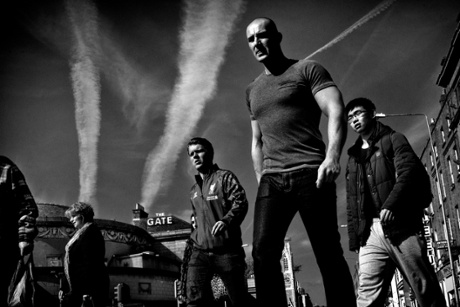
When Eamonn Doyle self-published his debut, i, last year, Martin Parr declared it “the best street photobook in a decade.” Doyle’s subjects were the elderly residents of working-class north Dublin. He shot them from above, as if looming over them while they went about their daily business.
These lone figures wandering their city lost in thought could not help but recall certain characters from James Joyce’s short story collection, Dubliners – though Doyle actually cited Samuel Beckett as his inspiration, alongside photographers such as Daido Moriyama and Garry Winogrand. “I’m fascinated by Beckett’s minimalism and reductivism, especially in how he drew out his characters and locations,” Doyle said. “I started to be drawn to these elderly solitary ‘Beckettian’ characters, people I’ve seen passing me on the street every day. They seemed to be treading the same ground day in, day out. ”
Like Trent Parke, Doyle took the tired tradition of street photography and revitalised it so much he can hardly be considered a street photographer at all. He is a fleeting portraitist, capturing the almost heroic stoicism that attends old age.
Now comes his second book, On, another limited edition with a dramatically graphic cover (in three different colour options) that suggests a meeting of Matisse and Russian constructivism. The location remains the same – Parnell Street and O’Connell Street in Dublin – but, this time, the subjects are younger and more varied in terms of ethnicity. Whereas i evoked an almost timeless Dublin, On shows a markedly contemporary city, where people stride purposefully onward, intent on their destination rather than their journey.
The first image captures three young men walking in unison but, most likely, barely aware of each other’s presence. Framed from below, the central figure has a hardness that borders on the aggressive: a demeanour familiar to anyone living in an inner-city environment. In the sky above him, vapour trails shoot upwards as if from the roof of the Gate theatre. But the drama that concerns Doyle is the everyday ebb and flow of the busy streets, which he renders in shady black-and-white images – a few pages are drenched in washes of crimson, so that part of the photograph is monochrome, part almost infrared.
Doyle often opts for dramatic angles; sometimes, he shoots his subjects so close he’s actually in their face. One man in a grey raincoat against a monolithic building stares back at his lens with a gimlet eye. Another younger man stands with his head bent as if in silent meditation but, more likely, in thrall to his mobile phone. A closeup of a woman in a headscarf makes her seem oddly holy, not unlike the religious statues of Our Lady that still dot the Irish landscape. In yet another strangely mythic image, a man in a hat and overcoat strides down a deserted street like the lone hero of an existential western – except the landscape is 1930s social housing.
Many of Doyle’s street photographs shade into portraits of isolation: single faces freeze-framed in the momentum of the city. Like Moriyama, he makes grotesque use of grainy tones and stark contrasts: the hanging fat on a woman’s freckled arm as she bends over her fast food leads the eye to her tight bra strap; the blood-encrusted cuts in a young man’s forehead, patched up with sutures; the wiry combover on the head of a man wearing an eye protector.
These are glimpses of an unreal city that is also palpably familiar; Doyle picks up the telling details that usually pass us by in our own haste. The term “street photographer” damns him with faint praise. Here is a chronicler of the city in all its myriad small dramas, and its inhabitants – who are as oblivious to each other as they are to the man with the camera at their heels.
- On is available now, published by Michael Hoppen.

